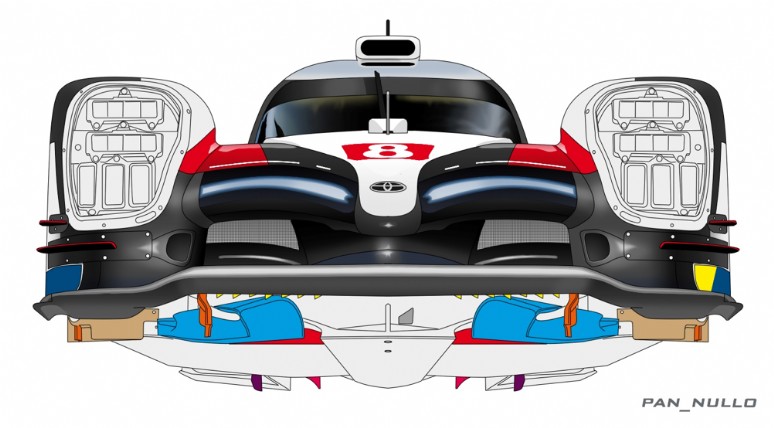22/06/2019 -
Le Mans 24h was the perfect event to conclude WEC superseason 2018-2019. LMP1 class has been entirely dominated, as expected, by Team Toyota with the 2 TS50 that started from front grid and challenge each other during the entire race. As is often the case also this edition has been decided during last hour, due to a puncture revealed on car #7 that in reality has been discovered to be a malfunctioning of TPMS System (Temperature and Pressure Monitoring System) that constantly control pressure and temperature inside the 4 tyres.
Result of LMP2 class has been more uncertain during the marathon with a very intense race pace.
Enso CLM P1/01 run Le Mans using the same front splitter with main section used on previous races, keeping the same blown flap characterized by different curvatures at wing tips, closed to inside surface of front fender.
Normally Le Mans calls for low downforce aero configuration in order to maximize performances on the long straights and circuit section run at high speed. It seems that working on the entire aero package the level of efficiency and downforce of this configuration resulted to be the best compromise.

Enso CLM P1/01 Detail of front splitter underside and blown flap
Bottom view of Enso CLM P1/01 front splitter reveals a VG’s row at approx. 50% of main chord.
As we discussed already this is a way to manipulate boundary layer that due to adverse pressure gradient tend to separate (flow is higly accelerated on the portion closed to leading edge and then progressively slow down increasing the local static pressure). Accelerated flow along the chord ensure stability of the boundary layer, conversely high adverse pressure gradient cause instability and ultimately flow separation.
Those effect creates oscillation of front downforce and sensitivity to variation of groud ride heigh. Vortex generators intruce energy remixing local boundary layer ensuring delay on separation.
 Enso CLM P1/01 Vortex Generator row on front splitter suction side
Enso CLM P1/01 Vortex Generator row on front splitter suction side
The drawing shows the front part of Toyota TS50 revealing the complex system of surfaces and aero appendages that enable the high level of downforce, with great efficiency, of actual LMP1 cars.
First thing to notice is the tick leading edge with large radius of the bodyworks bridging front nose to lateral front fender.
Front brakes airscope are located in strategic place on fender nose.
Row of Vortex generators is yellow painted; longitudinal strake (orange) are located to aerodynamically interfere with the area closed to front wheel controlling the vorticity typical of this zone and keep it separate by incoming flow that feed the bottom.
Turning vanes (light blue) are shaped with complex curvature and use two main surfaces to direct the flow coming from splitter trailing edge, diverging it alongside improving underflow pattern and feeding rear diffuser with cleaner airflow.
 Toyota TS50 – Front nose and underbody view of all different aerodynamics components
Toyota TS50 – Front nose and underbody view of all different aerodynamics components



 Enso CLM P1/01 Vortex Generator row on front splitter suction side
Enso CLM P1/01 Vortex Generator row on front splitter suction side Toyota TS50 – Front nose and underbody view of all different aerodynamics components
Toyota TS50 – Front nose and underbody view of all different aerodynamics components